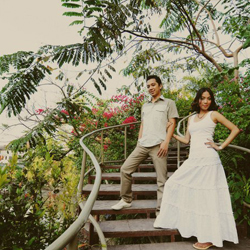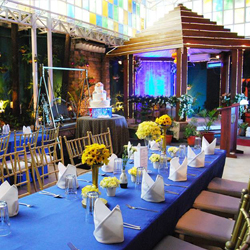Capiz – Seafood Capital of the Philippines
Another province in Panay Island, Capiz boasts of its rich marine life which supplies the seafood demand of Metro Manila and nearby provinces. Its 80-kilometer coastline and wide expanse of swampy lands are easily converted into fishponds. It holds one of the richest fishing grounds and a major contributor in the aquamarine industry of the Philippines. Capiz is also one of the country’s major suppliers of prawn and milk fish. Other agro-industrial harvests include blue marlin, squid, oysters, shrimp, seaweed, squid and angel wings.
Aside from its marine life, Capiz houses other treasures such as the biggest bell in Southeast Asia and the most versatile and commercially viable sea shell, the pi-os or the Capiz shell.
Demographics
1. Population –
701,664 (as of 2007 Census)
2. Land Area – 2,633.2 sq. km
3. Capital – Roxas City
4. Language/Dialect – Hiligaynon, English, and
Filipino
5. Divisions
Cities (1)
- Roxas City
Municipalities (16)
- Baao
- Cuartero
- Dao
- Dumalag
- Dumarao
- Ivisan
- Jamindan
- Ma-ayon
- Mambusao
- Panay
- Panitan
- Pilar
- Pontevedra
- President Roxas
- Sapi-an or Sapian
- Sigma
- Tapaz
Famous For ...
Capiz Shells
These shells, locally called pi-os, are said to be the
most versatile type of all sea shells. Its translucent
quality makes it in demand here and abroad. These shells
are made into different gift items and decors, even
as Christmas Lanterns (parol).
Sinadya
sa Halaran
This twin festival celebrates the feast of the Immaculate
Conception and the rich cultural heritage of Roxas City.
It is celebrated in a show of unity that speaks of their
determined quest for a better life.
Biggest
Bell in Southeast Asia
Found in Sta. Monica Church in the town of Pana-ay,
this 10.4 ton bell is seven feet in diameter, making
it the biggest in Southeast Asia.
Seafoods
The province is abundant in marine life like blue marlin,
tuna, prawns and shrimps, seaweed, crabs ells, and shellfish
such as oysters and mussels. Testaments of its abundance
are numerous mussel farms found near the town of Sapian.
Cultural
Ang Panublion
(Roxas City Museum)
Location: Roxas City, Capiz
Built in 1910 as a water tank, it house memorabilia
of illustrious sons and daughters of Roxas City. Inside
are collections of religious icons, artifacts, and artworks
Historical
President
Manuel Roxas National Shrine
Location: Roxas City, Capiz
The two-storey hardwood and stone house was the birthplace
of former President Manuel Roxas. The house was declared
as a national shrine in 1949
Moro Towers
Location: Sitio Nipa, Roxas City, Capiz
Built in 1814, these half-torn stone structures were
created to repel the invading Moors and Portuguese colonizers.
One tower is atop the hill in Sitio Nipa, the other
one is near Roxas City airport.
Roxas City
Bridge (Old Capiz Bridge)
Location: Roxas City, Capiz
The old and imposing bridge remained strong and firm
after it was built in 1910. Overlooking the Panay River.
Passing the major edifice of the city, the river of
Roxas City has been dubbed as the “Venice of the
Visayas”.
Man-Made
Mussel Farms
Location: Sitio Angkin, Sapian, Capiz
These mussel farms are found near the sea shore are.
Here, thousand of bamboo stilts are arrayed 6 feet apart
into the briny water. Each bamboo pole is stuck through
the sea floor 6 to 7 feet deep. Each one of these poles
yields hundreds of fat dark green mussels sticking on
each stilt.
Natural
Quipot Cave
Location: Bgy. Burias, Mambusao, Capiz
The cave consists of many chambers, each at a level
different from other chambers. In certain sections,
one has to crawl because the space between the roof
and cave floor is just two or three feet. There are
also sections that seem like a dead end, except for
small openings through which only one person can crawl.
These holes lead to a chamber as big as a hotel ballroom,
which is why it is dubbed as the “Quipot Hilton”.
Suhot Cave
Location: Dumalag, Capiz
It is actually a series of interconnected caverns of
different sizes. At the cave’s arched entrance
is a pool of clear, ice-cold water fed by a rock spring
from within the cave. Further on, however, is a crack
in the rocks where sulfurous water comes out. Suhot
is believed to have a connecting tunnel to the Badiang
Cave in Dumarao.
Badiang
Cave
Location: Dumarao, Capiz
Found on a higher elevation, Badiang Cave is believed
to have a connecting tunnel to the Suhot cave in Dumarang
since both caves are found in the same mountain only
6 km. apart from each other. The entrance to Badiang
is hidden by dense jungle.
Igang Cave
Location: Brgy. Tapulang, Maayon, Capiz
It has several entrances at different levels which lead
to a central chamber and fan out again to different
passages. Big star-like structures connect upper portions
to the central chamber, which is well lighted and well
ventilated. A gradually sloping passage, 7 feet wide
and a foot high, takes one to the lower chamber, which
unlike the upper and central chambers is dark. The floor
here is covered with guano which townspeople use as
fertilizer.
Suhoton Cave
Location: Jamindan, Capiz
It has several multi-layered chambers in its vast interior.
Inside one chamber is an altar-like formation surrounded
by stalagmites that seem like giant images in silent
repose. Some chambers are as big as hotel ballrooms
or cathedrals.
Mantalinga
Island
Location: Capiz
It is an ideal spot for scuba divers and a perfect rotunda
for sailboat (dilayag) and kayaking contests. Recently
named “Good Luck Island” by DOT consultants,
the place is believed by the local fisher folk as source
of luck when names of their fish boats are written on
the side of the island before it goes fishing for the
first time.
Napti Island
Location: Pan-ay, Capiz
It is gifted wiht white sand beach, a small cave, and
abundant shells for necklaces. The water is cool and
clear and free of troublesome jellyfish the whole year
round. A small cave, about 100 meters long, winds several
feet below the surface across the island. It commands
a breathtaking view of Roxas City and Pan-ay.
Olutayan
Island
Location: Roxas City, Capiz
Thirty feet below, multi-colored fishes cavort in flashes
of blue, yellow and red colors sliding through colorful
seaweeds. The island’s beach is carpeted with
tiny crushed shells called cascaho.
Tucad Reef
Location: Pilar, Capiz
This is a submarine islet of seashells and corals topped
with thin layers of sand. When the tide is low the whole
island emerges, and with it, shells and corals of different
colors - green, red, blue, pink, clear water. From this
marine garden, the mountains of Masbate can be seen.
Buntod Beach
Location: Pan-ay, Capiz
It is one of the cleanest beaches in Capiz. It has fine
black sand with a beach free of jellyfish all year round.
Vrigin Beach
Location: Ivisan, Capiz
This white sand beach has a beautiful ambiance and abundant
with seafood. There is an area in the beach where picnickers
can purchase seafoods on site.
Religious
Sta. Monica
Church
Location: Pan-ay, Capiz
Almost a small fortress, it is about 250 ft. long and
80 ft. wide with 9-ft. thick walls of coral blocks.
The central altar is an elaborately sculptured retablo
of silver and hardwood in florid Baroque style. Its
five story belfry shelters a huge antique bell surrounded
by 8 smaller bells. This bell is the largest in Southeast
Asia. It was cast from 76 sacks of coins believed to
have been contributed by the citizens of the town
Dumalag Church
Location: Dumalag, Capiz
Finished in 1872 during the time of Fr. Andel Abasolo,
the church is 200 feet long and 50 feet wide wiht walls
that are 3 feet thick and made of yellow sandstone.
At the front left side of the church is the 5-storey
belfry housing 5 bells of different sizes made in 1881.
The church’s interior is shaped like a cross.
Sinadya
sa Halaran
Place: Roxas City, Capiz
Date: December 4 - 8
It is a fusion of two festivals – “Sinadya”
(City) and “Halaran” (Province) which literally
means joy in sharing and thanksgiving. The highlights
of the celebration are the dancing parade, ”Higantes”,
fluvial parade, Mutya sa Halaran beauty pageant, and
agri-aqua trade fair.
Balintawakan
Festival
Place: Pontevedra, Capiz
Date: December 31
Its is a simple gathering, mostly of senior citizens
of Pontevedra, Capiz who are sentimentally bound together
to an unwritten commitment to preserve a simple tradition
which began long ago and was only interrupted by World
War II. People hold a Binayle at the town’s public
market followed by the search for Miss Balintawakan
as the Festival Queen and Rigodon de Honor.
By land:
Roll On-Roll Off (Ro-Ro) buses are operating to
fetch passengers from Manila (Cubao or Pasay)
to Roxas City via Manila – Batangas –
Mindoro - Catiklan, Aklan and vice versa.
By Air:
Travel time to Roxas City is 45 minutes by plane.
From Iloilo City, it is approximately 2 hours
by bus or private car.
By Sea:
hipping lines travel to the province from Manila
with 16-18 hours travel time.






